|
|
|
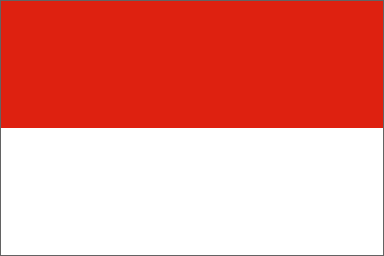 Temple
Temple 
The Sanjaya dynasty, which established the first kingdom of Mataram, was founded around 730 A.D. by Sri Maharaja Sanjaya ( See Hindu and Buddhist Period ).This marks the beginning of the historical period of Central Javan, here the first Hindi-Javan temple site of Dieng ("mountain of the gods") was built, on the 2 000 meter (6 560 feet) high plateau, which is the basin of the surrounding volcanic region.
| And so it is on the Dieng plateau that we can see the prototypes of all Hindu temples of Java, the simple models of later, larger richly decorated temples. Originally there were about forty - eight remain. a group of temples in the north of the plateau is named after the hero of the epic the Mahabharata, Arjuna, though this was probably a later addition. The epic describes the eternal struggle between good and evil, and the battle of the Pandawa brothers against the Korawa brothers, all descendants of the Bharata. The Arjuno group consists of the temples (candi) Semar, Puntadewa, Srikandi, and Sembadra. The relatively small buildings are constructed on marshy ground and all follow the same pattern: "From a square base rises a smaller cella that opens to the west; this cella has a stepped roof which repeats the shape of the cella with lingams and stupas". Over this rises a stepped temple tower that repeats the shape of the cella. Above the entrance to the cella is a constantly recurring motif, the sculpted head of Kala, son of the Shiva. The head of a demon, it is meant to ward off evil. Opposite the temples themselves is a subsidiary temple, the purpose of which is unclear. maybe it served the priests as a living area or was a repository or objects used in rituals. all temples were probably dedicated to the main deities of the Trimurti (brahma, Vishnu, and Shiva), though the only temple which in fact has the Trimurti carved on the exterior walls of the cella is the Candi Srikandi: in the south, brahma, the creator of the world; in the north Vishnu, the protector of the world; and in the east , hiva, the destroyer and rebuilder of the world. | 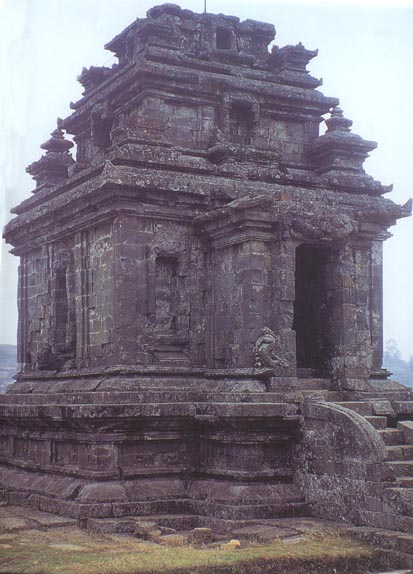 Candi Arjuno - A.D. 680 - 730, Dieng plateau, Central java. |
Borobudur:
Around 1 300 years after the life of the historical Buddha, the largest buddhist building in the world was built in central Java: The "world mountain", Borobudur.
| Three central elements of
Buddhism are expressed here in the architectural form of
the stupa, the Meru, and the mandala. The stupa developped historically from the stone-age burial mounds that in earlier times were reserved for important rulers. Later, stupas were generally built at a crossroads and contained the ashes or relics of holy men, which the people revered by walking round in a clockwise direction. The Borobudur, which was erected on the side of a natural hill and so has no interior rooms, culminates in the largest stupa in the world. the Meru is a representation of the mythical world mountain, Mount Meru, on whose summit the gods live. In order to be nearer to the gods, the builders constructed a pyramid whose steps are the natural hill, a terraced holy shrine. With every step pilgrins climb they symbolically achieve one more step in their spiritual development and so reach a higher state of consciousness. The mandala is the symbolic representation of the world and the spiritual creatures who go to make it up. A mandala serves as a pattern for meditation and as an aid (yantra) in achieving concentration and the state of meditation. The Borobudur is a three-dimensionnal mandala in which architecture and sculpture work in harmony; the Borobudur-mandala guides pilgrims along the stepped path that climbs through the three spiritual realms. The mandala symbolizes that process through which the soul is liberated from its early life in order to attain perfection at the highest stupa: a meditative pilgrim's way to Nirvana, the state of non-existence sought by the Buddhist. |
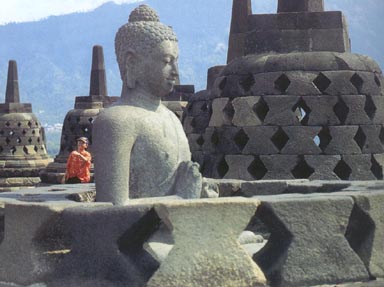 Borobudur - Central javan period (A.D. 732 - 928), Borobudur, Magelang, Central Java.
Head of a transcendental Buddha from Borobudur - Central Javan period (A.D. 732 - 938), andesite. |
| On their symbolic path to Nirvana, the devotees have been able to admire 432 Buddhas in high relief in the niches above the gallery passages. Each of these has a typical mudra (hand position). On the eastern side is the bhumisparshamudra, indicating reasonning; on the south, the waradramudra, meaning granting wishes. On the west is the dhyanamudra, indicating meditation, and on the north the abhayamudra, representing fearlessness. With the 72 stupa Buddhas on the highest circle, we have a total of 504 statues of Buddha on this highest spiritual level. |  Aerial view of Borobudur. |
Candi Prambanan:
The new temple site of Prambanan was built as a stone symbol of the victory over the Sailendras. Under the ruler Sri Maharaja Rakai Pikatan, the site was built with an original total of 232 shrines, ans was completed around 915 A.D. under King Daksha. A devastating earthquake destroyed the whole complex in 1549.
| Today we can once again admire
the eight main temples, for they have been reconstructed.
The three largest are arranged in a square courtyard on a
north-south axis. They symbolize the Trimurti, the hindu
trinity. In the middle, the main temple, 56 meters (184
feet) high, is dedicated to Shiva; next to it, to the
south, is the temple to Brahma and to the north the
temple dedicated to Vishnu, both 37 meters (121 feet)
high. Opposite these three temples are three more
shrines, which contain the mythical animals which the
Trimurti used for mounts: Shiva's bull, called Nandi;
Brahma's gander, Hamsa; and Vishnu's sun-bird, Garuda. At
the northern and southern entrance doorways stand two
identifical buildings which possibly served as places to
keep cult objects. All other 224 shrines lie in ruins
today. The Prambanan style is considered to mark the transition from the Central to the East Javan style. |
 Candi Prambanan - 9th century, Hindu, Central Java. |
Bali:
At the beginning of the 16th century, when the Majapahit empire had moved further east, a period of independant cultural development began on Bali. Nowhere else on earth are there as many temples as in Bali. The number is estimated at around 20 000. There are family temples, temples serving several families, temples for individual territories, temples for all bali, and three obligatory temples for each village.
| The temple of Besakih, the "mother of all the temples", lies at the foot of the highest mountain in Bali, the Gunung Agung. This, the largest temple site in Bali, in which every village is represented by sacred building, is an excellent illustration of the structure of a temple site. Characteristic of Besakih is the large number of Merus: wooden constructions with pagodas-like roofs covered in palm fibers that are piled up on top each other and taper off in size as they rise. These symbolize the mythological world mountain, the seat of the gods. The number of roofs is always an odd number, from three to eleven. Shiva given eleven roofs, Brahma and Vishnu nine, and the ancestors are allocated the other numbers. A wealth of small subsidiary temples adjoins the main site. the fact that the temple site is divided into three again symbolizes the Trimutri, the Hindu trinity of Shiva, Brahma and Vishnu. as the indisputable main divinity, Shiva especially is honored in the inner sanctum. | 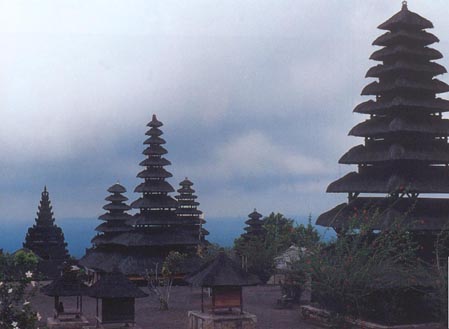 Pura Besakih - Bali's principal temple, with it's spectacular setting on the slopes of Gunung Agung. |
| A further important temple connected with the Besakih s the Goa Lawah, situated on the straits of Badung. Goa means "cave" Lawah "bat", and thousands of bats, regarded as holy, nest inside the cave and on its exterior walls. This "cave of bats" leads deep into the mountain and is supposed to end at the Gunung Agung; in this way there is a direct link between this temple and the temple of Besakih. The snake of the underworld, Basuki, is supposed to live in the cave, and the first shrine at Besakih is supposedly dedicated to him; in the inner courtyard a stone throne is dedicated to him and the mythical snake Antaboga. Goa Lawah is the underworld counterpart to Besakih, which is seen as occupying the upper-world. | 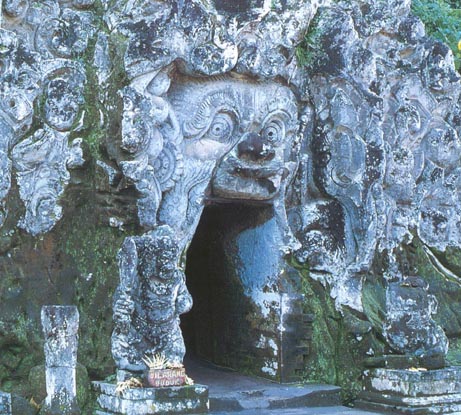 Goa-Gajah grotto - A.D. 1000 - 1100, Bedulu, Gianyar - Bali. |
| Pura Ulun Danu Bratan, this Hindu/Buddhist temple was founded in the 17th century, and is dedicated to Dewi Danu - the goddess of the waters. It is the focus of ceremonies and pilgrimages to ensure the supply of water. It situated on Lake Bratan in north Bali. It has classical Hindu thatched-roof merus (multi-roofed shrines) and an adjoining Buddhist stupa. Before people go into the Hindu-Balinese temple sites, they pass on the left of the double gate a pagoda in whose niches sit five meditating Buddhas, a sign of the adoption of elements of Buddhist belief into the Balinese form of Hinduism. | 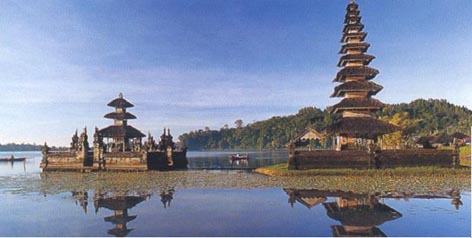 Pura Ulun Danu Bratan - Lake Bratan - Bali. |